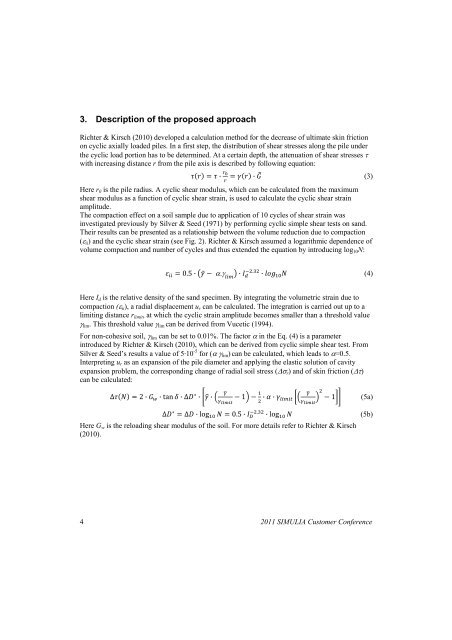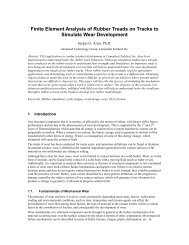Behavior of Foundation Piles for Offshore Wind Energy ... - SIMULIA
Behavior of Foundation Piles for Offshore Wind Energy ... - SIMULIA
Behavior of Foundation Piles for Offshore Wind Energy ... - SIMULIA
You also want an ePaper? Increase the reach of your titles
YUMPU automatically turns print PDFs into web optimized ePapers that Google loves.
3. Description <strong>of</strong> the proposed approach<br />
Richter & Kirsch (2010) developed a calculation method <strong>for</strong> the decrease <strong>of</strong> ultimate skin friction<br />
on cyclic axially loaded piles. In a first step, the distribution <strong>of</strong> shear stresses along the pile under<br />
the cyclic load portion has to be determined. At a certain depth, the attenuation <strong>of</strong> shear stresses τ<br />
with increasing distance r from the pile axis is described by following equation:<br />
���� ��· ��<br />
� ����� ·�� (3)<br />
Here r0 is the pile radius. A cyclic shear modulus, which can be calculated from the maximum<br />
shear modulus as a function <strong>of</strong> cyclic shear strain, is used to calculate the cyclic shear strain<br />
amplitude.<br />
The compaction effect on a soil sample due to application <strong>of</strong> 10 cycles <strong>of</strong> shear strain was<br />
investigated previously by Silver & Seed (1971) by per<strong>for</strong>ming cyclic simple shear tests on sand.<br />
Their results can be presented as a relationship between the volume reduction due to compaction<br />
(εii) and the cyclic shear strain (see Fig. 2). Richter & Kirsch assumed a logarithmic dependence <strong>of</strong><br />
volume compaction and number <strong>of</strong> cycles and thus extended the equation by introducing log10N:<br />
� �� �0.5·���� α.γ ��� �·� � ��.�� ·������ (4)<br />
Here Id is the relative density <strong>of</strong> the sand specimen. By integrating the volumetric strain due to<br />
compaction (εii), a radial displacement ur can be calculated. The integration is carried out up to a<br />
limiting distance rlimit, at which the cyclic strain amplitude becomes smaller than a threshold value<br />
γlim. This threshold value γlim can be derived from Vucetic (1994).<br />
For non-cohesive soil, γlim can be set to 0.01%. The factor α in the Eq. (4) is a parameter<br />
introduced by Richter & Kirsch (2010), which can be derived from cyclic simple shear test. From<br />
Silver & Seed’s results a value <strong>of</strong> 5·10 -5 <strong>for</strong> (α γlim) can be calculated, which leads to α=0.5.<br />
Interpreting ur as an expansion <strong>of</strong> the pile diameter and applying the elastic solution <strong>of</strong> cavity<br />
expansion problem, the corresponding change <strong>of</strong> radial soil stress (Δσr) and <strong>of</strong> skin friction (Δτ)<br />
can be calculated:<br />
Δ���� �2·� � ·tan�·Δ� � ·���·� ��<br />
� �����<br />
�1�� �<br />
� ·�·������ �� ��<br />
�<br />
������ �<br />
�1�� (5a)<br />
Δ�� ��.�� �∆�·log�� ��0.5·�� ·log�� � (5b)<br />
Here Gw is the reloading shear modulus <strong>of</strong> the soil. For more details refer to Richter & Kirsch<br />
(2010).<br />
4 2011 <strong>SIMULIA</strong> Customer Conference



